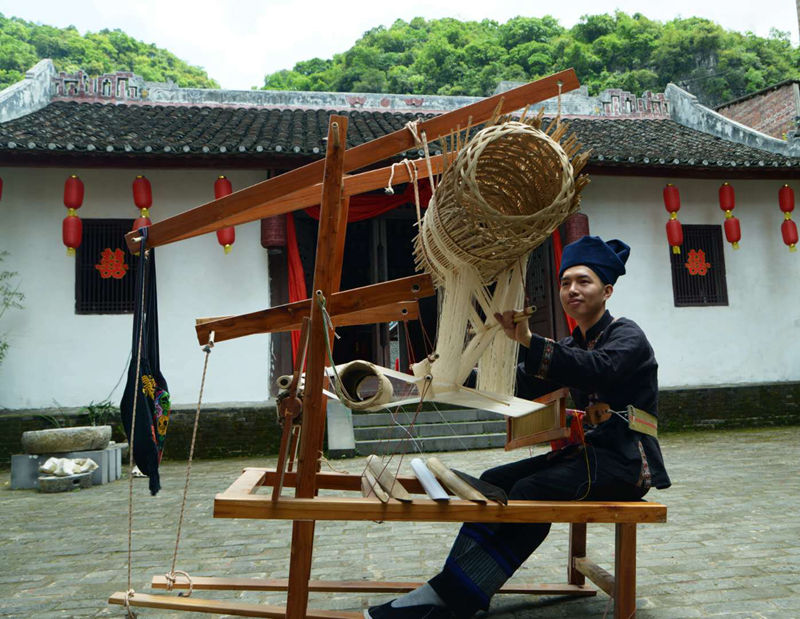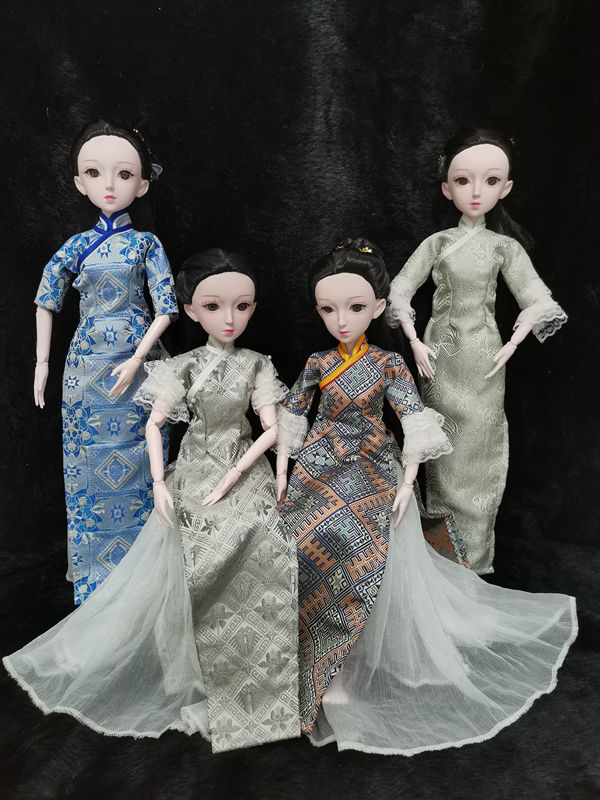

(Video produced by Ma Tianyi, Du Mingming and Alvaro Lago)
An iconic part of Zhuang ethnic culture, Zhuang brocade is renowned for its variety of colors and intricate patterns. Together with Shu, Yun, and Song brocade, they are regarded as China’s four most famous brocade styles.
Xincheng County, in Laibin City of south China’s Guangxi Zhuang Autonomous Region, is famous for being the cradle of Zhuang brocade. For over a thousand years, the county has laid a profound cultural foundation for the art and developed outstanding weaving techniques.
Due to its complexity, only a few people have managed to master the art of Zhuang brocade weaving. 34-year-old Liang Hengyuan is one of them. Together with his 26-year-old cousin Lan Peiwen, the two male inheritors have dedicated themselves to bringing this traditional art back to its former glory, while at the same time integrating it with poverty relief efforts.
Inherit and innovate
Liang started learning brocade weaving when he was 13 years old, but only started taking it seriously five years later.

Liang Hengyuan, a representative inheritor of Zhuang brocade, demonstrates weaving techniques in Xincheng County, Laibin City of south China’s Guangxi Zhuang Autonomous Region. (Photo provided to People’s Daily Online)
"When I was studying in Liuzhou [city of Guanxi], I often went to the museum. Once, I saw Xincheng Zhuang brocades on display, and I saw some of my family’s brocades from when I was back home. At that time, I thought that someone had to pass on this classic folk art," said Liang.
None of the young women in Liang’s family were willing to learn brocade, and his parents objected to his decision to get into the Zhuang brocade business to begin with. However, when Liang successfully wove a brocade duplicate that none of his family members were able to, his parents changed their minds.
With his mother’s help, Liang wove the first batch of Zhuang brocades in 2014, turning them into fashionable bride and groom costumes. With their strong local ethnic characteristics, they proved a hit with customers.
Liang then realized that to broaden his market, he had to inject new vitality into his work through innovation. For the next few years, he and his cousin Lan Peiwen traveled to many parts of China and Southeast Asia to learn advanced weaving and dying techniques.
They incorporate fashionable elements with traditional Zhuang brocade, making product lines that meet the needs of the modern market.

Dolls in Zhuang brocade Qipao clothes (Photo provided to People’s Daily Online)
For instance, the popularity of court operas and Hanfu in recent years has given Liang a new source of inspiration, driving him to create a series of "Barbie Doll Souvenirs", integrating the weaving skills of traditional Zhuang brocade into cultural and creative figures. These vivid and classical dolls became very popular with consumers when they hit the market.
Used for poverty relief
To better protect and pass on the technique to future generations, Xincheng County has set up a Zhuang brocade productive protection and demonstration base. Built on the site where ancient government officials of Xincheng County used to have their residences, the base establishes a characteristic industrial chain for the integration of intangible cultural heritage with poverty alleviation.

Lan Peiwen, an inheritor of Zhuang brocade, demonstrates weaving techniques in Xincheng County, Laibin City of south China’s Guangxi Zhuang Autonomous Region. (People’s Daily Online/Yan Lizheng)
Lan Peiwen is in charge of the Zhuang brocade base. In addition to showcasing and passing on the traditional weaving techniques, he directs local people in introducing many of the novel pattern designs and continuously enriching the product types, bringing a new lease of life to the traditional art.
As it’s a characteristic handicraft of the Zhuang ethnic group, passing down the art of brocade is particularly important. With the support of the local authority, a flexible employment base was established at the Zhuang brocade base. It offers a one-month training course on Zhuang brocade technique at least once a year, taking in 20 impoverished local people for each course.
Students who have completed the training can get a job provided by the employment base, which allows them to choose to work in the base’s brocade workshop or take raw materials from the base and finish their work at home. Jobs provided by the employment base can increase local people’s incomes by an average of around 15,000 yuan a year.
“When a student knows how to weave Zhuang brocade, he or she can teach it to other people. In this way, more people will be able to learn the skills, and the craft can be passed on while at the same time providing more employment opportunities,” said Lan.

A worker makes Zhuang costumes at the Zhuang brocade workshop in Xincheng County, Laibin City of south China’s Guangxi Zhuang Autonomous Region. (People’s Daily Online/Du Mingming)
According to Lan, the base also works together with many universities, vocational schools, and even middle schools and primary schools to teach students Zhuang brocade skills or demonstrate it to them.
Live-streaming e-commerce has become a buzzword for people seeking to sell their products online. According to a report by iiMedia Research, the number of users in China's live-streaming industry is expected to reach 526 million in 2020, and the market size looks set to exceed 900 billion yuan. Lan often encourages his students to start their own businesses on online platforms.
All the hard work seems to be paying off. Xincheng Zhuang brocade products now are not only known throughout China, but have also gained a market in ASEAN countries, and are even exported to Europe and America.
According to local official Zeng Yanqun, Xincheng County will further promote the model combining intangible cultural heritage with e-commerce and poverty alleviation in order to create jobs and raise incomes for more poor households.

 Award-winning photos show poverty reduction achievements in NE China's Jilin province
Award-winning photos show poverty reduction achievements in NE China's Jilin province People dance to greet advent of New Year in Ameiqituo Town, Guizhou
People dance to greet advent of New Year in Ameiqituo Town, Guizhou Fire brigade in Shanghai holds group wedding
Fire brigade in Shanghai holds group wedding Tourists enjoy ice sculptures in Datan Town, north China
Tourists enjoy ice sculptures in Datan Town, north China Sunset scenery of Dayan Pagoda in Xi'an
Sunset scenery of Dayan Pagoda in Xi'an Tourists have fun at scenic spot in Nanlong Town, NW China
Tourists have fun at scenic spot in Nanlong Town, NW China Harbin attracts tourists by making best use of ice in winter
Harbin attracts tourists by making best use of ice in winter In pics: FIS Alpine Ski Women's World Cup Slalom
In pics: FIS Alpine Ski Women's World Cup Slalom Black-necked cranes rest at reservoir in Lhunzhub County, Lhasa
Black-necked cranes rest at reservoir in Lhunzhub County, Lhasa China's FAST telescope will be available to foreign scientists in April
China's FAST telescope will be available to foreign scientists in April